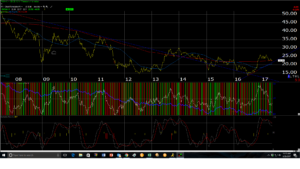The Financial sector has traded quite punk since March 1, 2017, the day after President Trump’s address to the joint session of Congress. Part of this – no doubt – is a continued flattening of the yield curve, with the absence of inflation, and the FOMC trying to “normalize” short-term interest rates. The odds of a June ’17 rate hike still remain elevated – last I looked between 70% – 80% – but much will depend on this coming week’s May ’17 employment report.
While the higher short-term interest rates help the Financial system in terms of generating spread income, it seems that the slope of the Treasury yield curve is far more important over time.
The Treasury yield curve has flattened since the 10-year Treasury has rallied from 2.60% to this week’s 2.25%. (The 10-year Treasury yield is nearing critical support. See chart below.)
The Financial sector is up just 1.24% year-to-date (YTD) according to Bespoke’s weekend missive, under-performing the SP 500 by 667 basis points. Far better than Energy and Telecom, but still way less than the SP 500’s 7.91% YTD return:
- Technology: +19.59% (largest client overweight. Nasdaq up just 6% – 7% in 2016, but pulling the performance sled in 2017)
- Cons Disc: +11.28% (Amazon is big part of this sector return. Amazon not a tech co w/in SP 500, but Consumer Discretionary component. Long AMZN)
- Hlth Care: +9.98% (under weight for clients but gradually lifting biotech and H/Care weighting)
- Ute’s: +9.35% (none)
- Cons Spls: +8.95% (scattered holdings)
- SP 500: +7.91%
- Industrials: +6.87% (GE largest Industrial long, dramatically under-performing other industrial stocks. Frustrating beyond belief)
- Basic Mat: 6.08% (None. Tough sector to invest, low-return commodity businesses which always seem perpetually cheap on valuation)
- Real Estate: +3.98% (none, avoiding due to money that poured in during “safety / dividend trade” from ’08 to ’16.)
- Financials: +1.24% (overweight)
- Telco: -11.64% (none for years, dividend yields are very tempting but be very careful.)
- Energy: -12.16% (sold remaining XLE this week. Sector hasn’t rallied on good fundamental news, better prospects for global growth. Fear of more US supply is keeping lid on crude oil prices.)
Source: Bespoke Report dated 5/26/17
So how does the Financial sector look through early 2018 in terms of expected revenue and earnings growth ?
Financial Sector (actual and expected earnings growth)
- Q1 ’18: +10.8%
- Q4 ’17:+17.2%
- Q3 ’17:+7.1%
- Q2 ’17:+9.6%
- Q1 ’17:+19.9%
- Q4 ’16: +11.6%
- Q3 ’16:+8.5%
- Q2 ’16: -4%
- Q1 ’16:-10.4%
- Q4 ’15: +2.5%
Source: Thomson Reuters I/B/E/S
Readers can see that the “great” year-over-year earnings growth for the Financial sector in Q1 ’17, was driven as much by weaker comp’s from Q1 ’16 than anything else. Q2 ’17 should also see some stronger growth thanks to the weaker Q2 ’16 as well.
Here is what caught my eye though: Historical revenue growth of the Financial sector
- Q1 ’17: +8.8%
- Q4 ’16: +4.0%
- Q3 ’16: +6.9%
- Q2 ’16: +0.9%
- Q1 ’16: -1.2%
- Q4 ’15: +2.7%
- Q3 ’15: +1.0%
- Q2 ’15: +4.6%
- Q1 ’15: +4.1%
- Q4 ’14: +0.7%
- Q3 ’14: +5.0%
- Q2 ’14: +0.8%
- Q1 ’14: -1.9%
- Q4 ’13: -10.9%
- Q3 ’13: +0.2%
- Q2 ’13: +6.2%
- Q1 ’13: +4.1%
- Q4 ’12: +20.7%
Source: Thomson Reuters I/B/E/S historical data
2011 was a tough year for the SP 500 and the stock market as a whole, so the Q4 ’12 +21% revenue growth may be lapping the tough comp of the 2011 issues. The SP 500 only rose 1% on 2011, and it was down 20% year-to-date as of the start of October, 2011.
Conclusion:
- If Q4 ’12 revenue growth is excluded from the above data set, Financial sector revenue growth “averaged” just 1.5% from 2013 – through Q4 ’16 2016.
- If the period from Q1 ’14 through Q4 ’16 is exclusive, the “average Financial sector revenue growth rises to 2%
- If the period from Q1 ’15 through Q4 ’16 is exclusive, the average Financial sector revenue growth rises to 2.9%
And therein lies the problem with the Financial sector.
Here is a “yield” chart of the 10-year Treasury

This is a CBOE (Chicago Board of Options) 10-year Treasury Yield Index. It is a “weekly” chart that clearly shows the double-bottom in the 10-year Treasury yield near 1.33% – 1.39% in both July 2012 and early July, 2016.
The chart also shows a 10-year Treasury yield that trades below 2.10 – 2.15% (note trendline) will mean the uptrend in Treasury yields that started last July ’16 is now broken.
Part II to follow Tuesday, May 30th.
Thanks for reading.
